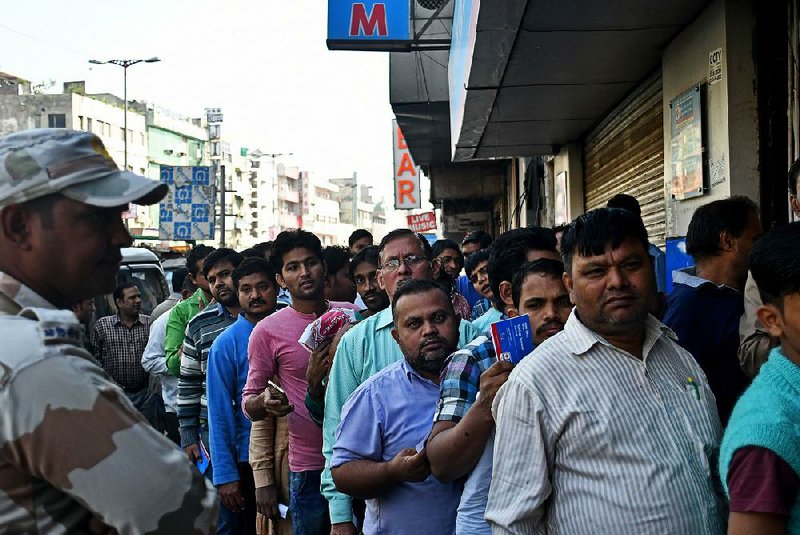Just over two weeks into its biggest fight against tax evasion and graft, India's regulatory flip-flops are confusing citizens and sparking criticism of the government's planning.
Prime Minister Narendra Modi's Nov. 8 decision to invalidate 86 percent of currency in circulation has affected pensioners to tourists in a nation where almost all payments are made in cash and about half the population lacks a bank account. What's made matters worse, however, is that bureaucrats tasked with the move have reversed rules twice a day on average.
"That reflects very poorly on the prime minister's office, on the finance minister's office and on the Reserve Bank of India," Manmohan Singh, Modi's predecessor and a respected economist, told lawmakers Thursday. "All these measures convince me that the way this scheme has been implemented is a monumental management failure, and in fact, it is a case of organized loot, legalized plunder of the common people."
At the core of the issue is how long Indians have to revalidate their now worthless bank notes. A Nov. 11 statement from the monetary authority said physical bills can be exchanged at banks until Dec. 30.
"As there is ample time, people need not rush to exchange, putting avoidable strain on the banking branch network," the RBI said in a statement answering Frequently Asked Questions. It has updated the FAQs nine times, highlighting amendments made along the way.
Then, late on Friday, the government said commercial banks would no longer exchange the notes. As a stunned citizenry took to social media to complain about institutional credibility, the Reserve Bank of India the next morning clarified that its own counters would stay open.
On Nov. 22, the government banned the deposit of 500 and 1,000 rupee notes in small savings programs offered by post offices, which dot the rural landscape where most banks don't reach. The concern for the government was that people would use the post office accounts to stash their unaccounted income away from the prying eyes of the government.
Modi's administration the next day amended the order, allowing unlimited investments into post office savings accounts, where officials lack machines to check counterfeit currency.
"We all want to get to a cashless society, but before we get to a cashless society, sir, we can't be in lu-lu land," opposition lawmaker Derek O'Brien said on Thursday, addressing Modi in parliament. "You have made 24 changes from the time of the announcement. Every time you make a change, you say 'No, no, this is just to recalibrate it.'"
Perhaps the most amusing of the flip-flops has been the government's sympathy -- or lack of it -- for young couples. With almost half the population under the age of 25 and October-March being the peak wedding season, the amount of cash in the system shoots up as everything from marigold garlands to calorific desserts are paid for in bank notes.
The sudden clampdown on cash, therefore, caused a panic, considering the cash demands of a traditional Indian wedding.
So loud was the outcry that the government relented last week and said those getting married could withdraw as much as 250,000 rupees from their bank accounts on proving that they were indeed getting married. But how do you prove that? Daunted, the government issued another notification deleting the relaxation.
When the public again questioned the quiet change, the government's press office posted a message on its Twitter account, "MYTH: Order withdrawn. REALITY: No, only technical correction."
When clarifications were issued, they didn't do much to simplify matters. First, only the bride, the groom or one of their parents could withdraw the cash. Second, they'd need to furnish wedding cards and receipts from caterers and the like, plus declarations pledging that the vendors didn't have bank accounts.
"Banks shall keep a proper record of the evidence and produce them for verification by the authorities in case of need," the monetary authority said in a statement. "The scheme will be reviewed based on authenticity/bona fide use thereof."
There's also confusion on exemptions being provided. Here's a handy guide: Old 500 rupee bills can still be used to pay school fees as well as to fill gas tanks, buy medicines and top off mobile phone cards. Air and railway ticket purchases can be made using them, and they can still be used for entry at certain historical sites, such as the Taj Mahal. The ban on 1,000-rupee notes, however, remains.
Foreigners can exchange foreign currency up to 5,000 rupees per week, as long they are willing to let an Indian bank official make a note in their passports, the finance ministry said on Thursday.
"While it takes political courage to launch such a trailblazing and massive campaign, it actually takes far more wisdom to give it a happy ending," Shi Lancha, a visiting scholar at Tsinghua University, wrote in China's Global Times newspaper.
Business on 11/26/2016
